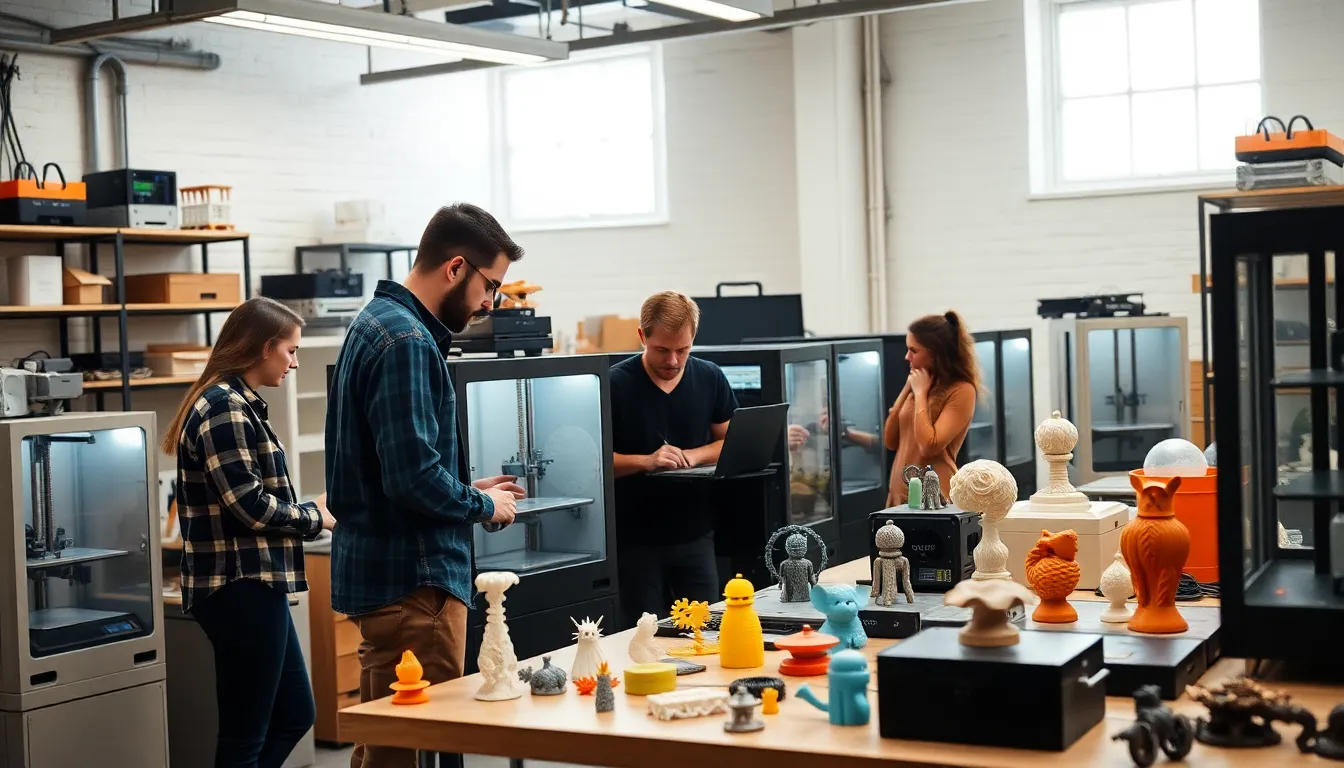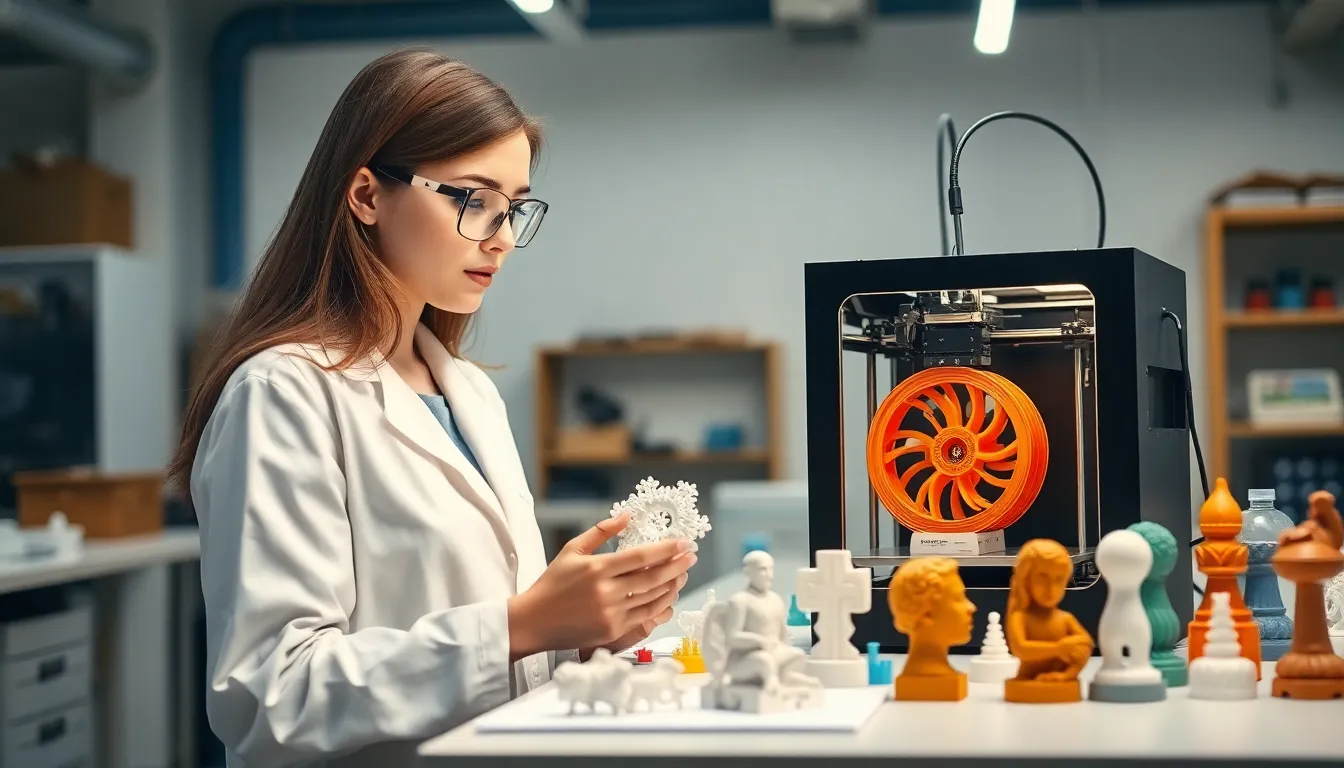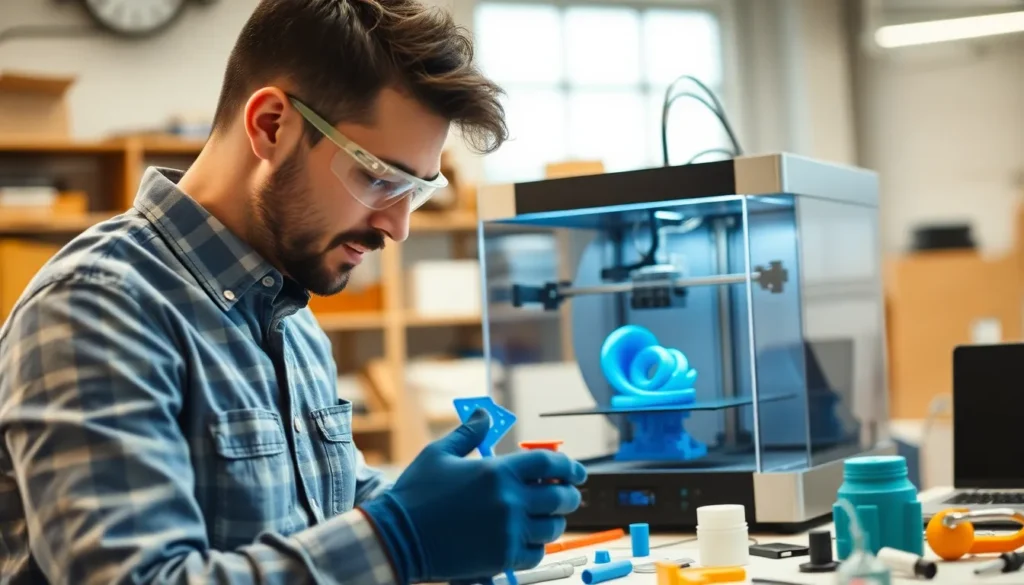Table of Contents
ToggleIn a world where everything seems to be just a click away, 3D fabrication techniques are the magic wands turning dreams into reality. Gone are the days of imagining that perfect gadget or custom piece of art; now, with a sprinkle of creativity and a dash of technology, anyone can bring their wildest ideas to life. It’s like having a mini factory right at your fingertips, minus the hard hats and safety goggles.
Overview of 3D Fabrication Techniques
3D fabrication techniques encompass various methods that convert digital designs into physical objects. These techniques include Fused Deposition Modeling (FDM), Stereolithography (SLA), and Selective Laser Sintering (SLS), among others. Each technique has unique advantages suited for specific applications.
Fused Deposition Modeling stands out for its affordability and ease of use. This method involves extruding thermoplastic filaments to build layers. Users often favor FDM for prototyping and creating functional parts due to its speed and versatility.
Stereolithography utilizes UV light to solidify liquid resin, layer by layer, resulting in high-resolution prints. Its precision makes SLA ideal for applications requiring detailed designs, such as jewelry and dental models. Many designers choose SLA for intricate features that FDM cannot achieve.
Selective Laser Sintering employs a laser to fuse powdered material, creating strong and complex geometries. Costly equipment limits this technique’s accessibility, but manufacturers value its durability for production-grade parts. Many industrial sectors rely on SLS to produce strong prototypes and end-use components.
Binder Jetting represents another notable option, combining powdered materials with binding agents. This method facilitates faster printing speeds and produces large parts efficiently. It finds applications in metal and ceramic printing, catering to markets that require unique material properties.
Digital Light Processing, similar to SLA, uses light to cure resin, offering enhanced speed and object size. Its growing availability makes it a desirable choice in industries focusing on high-quality end products. Many businesses leverage DLP for consumer goods and prototypes.
Understanding these 3D fabrication techniques helps individuals and businesses choose the right method for their projects, turning imaginative concepts into reality.
Common 3D Fabrication Techniques

Various 3D fabrication techniques enable diverse applications, each offering unique benefits for users.
Fused Deposition Modeling (FDM)
Fused Deposition Modeling (FDM) remains popular due to its affordability and simplicity. This technique utilizes thermoplastic filaments, which are heated and extruded through a nozzle to create layers. Users appreciate FDM for its accessibility, provided by numerous desktop 3D printers available on the market. Materials commonly used include PLA and ABS, offering durability and ease of printing. Many hobbyists and educators favor FDM for prototyping and educational purposes, while businesses leverage it for cost-effective production of functional parts in various industries.
Stereolithography (SLA)
Stereolithography (SLA) excels in producing high-resolution prints, meeting the demands of detailed designs. This method employs a UV laser that cures liquid resin into solid layers, resulting in intricate and smooth surface finishes. Designers and engineers value SLA for its precision, which benefits applications such as jewelry design and dental models. Various resins are available, allowing customization according to specific project requirements. Users often take advantage of SLA’s ability to produce complex geometries with exceptional detail that other methods may struggle to achieve.
Selective Laser Sintering (SLS)
Selective Laser Sintering (SLS) is renowned for creating durable and strong prototypes through a powder-based approach. A laser sinters powdered materials, typically nylon or metal, layer by layer until the final product forms. Industries focused on functionality, like aerospace and automotive, utilize SLS for its robust components, capable of withstanding rigorous conditions. Designers value SLS for its minimal support structures and the ability to produce complex geometries. This versatility makes SLS a preferred choice for both low-volume production runs and highly durable prototypes across multiple applications.
Applications of 3D Fabrication Techniques
3D fabrication techniques find extensive applications across various fields, translating innovative concepts into functional products.
Prototyping
Prototyping represents a primary application of 3D fabrication techniques. Designers and engineers often turn to Fused Deposition Modeling for rapid prototyping because it allows for quick iterations of design. Stereolithography serves this purpose by delivering high-resolution prototypes, which aid in evaluating aesthetics and functionality. Selective Laser Sintering produces durable prototypes that can withstand testing in real-world scenarios. Many industries rely on these methods to save time and reduce costs while developing products. These prototyping capabilities lead to efficient feedback loops that enhance overall design processes.
Manufacturing
Manufacturing processes greatly benefit from 3D fabrication. Large-scale production becomes feasible with techniques like Binder Jetting, which efficiently creates complex parts. Companies embrace the advantages of on-demand manufacturing, which significantly cuts down waste and inventory costs. Digital Light Processing produces high-quality, detailed components for specialized applications. Customization plays a vital role; businesses can tailor products to specific customer needs, leading to increased satisfaction. Traditional manufacturing constraints diminish, allowing for innovative designs and rapid scaling of production.
Medical Uses
Medical fields leverage 3D fabrication for personalized solutions. Custom prosthetics and implants utilize Stereolithography and Selective Laser Sintering to ensure precise fits and enhance patient comfort. Bioprinting, an emerging technique, is paving the way for creating tissue and organ models, offering significant advancements in research and surgical planning. Many dental applications use these technologies to produce aligners and crowns tailored to individual patients’ needs. Reduced lead times and exceptional customization significantly enhance treatment outcomes and patient experiences.
Advantages and Limitations
3D fabrication techniques present several advantages alongside notable limitations. Understanding both aspects helps individuals and businesses make informed decisions.
Benefits of 3D Fabrication
Cost efficiency stands out as a primary benefit. Techniques like Fused Deposition Modeling (FDM) enable affordable prototyping, minimizing expenses for startups and small businesses. Customization emerges naturally, allowing for personalized products that meet specific needs. Speed of production also increases, with rapid iteration making design adjustments quick and efficient. High-resolution outputs from Stereolithography (SLA) cater to industries requiring intricate details, such as jewelry and dental applications. Additionally, these methods foster innovation, providing a platform for creative experimentation without heavy investment in traditional manufacturing.
Challenges in 3D Fabrication
Despite the many benefits, challenges exist. Material limitations can hinder the usability of 3D printed products, with certain applications requiring materials that aren’t always compatible with every technique. Print quality varies depending on the method used, affecting durability and precision. Size restrictions also pose problems; many 3D printers are limited in the dimensions they can accommodate. Post-processing steps are often necessary to achieve desired finishes, adding time and labor costs. Furthermore, expertise in design and operation is essential for optimal outcomes, making training crucial for effective implementation in business settings.
Future Trends in 3D Fabrication Techniques
3D fabrication techniques continue to evolve, pushing boundaries in design and manufacturing. Advancements in materials are transforming capabilities, with innovations like biocompatible filaments and advanced polymers arising. These materials enhance application potential across various fields, particularly in medicine and aerospace.
Sustainability emerges as a key focus in 3D fabrication. Techniques that reduce waste and utilize recycled materials gain traction, supporting eco-friendly practices. Companies actively adopt these practices to align with consumer demand for sustainable solutions.
AI integration marks another significant trend. Artificial intelligence streamlines design processes, optimizing print settings for improved quality and efficiency. This technology empowers users to automate complex tasks, resulting in faster production times and reduced resource consumption.
Customization expands beyond traditional limits. Industries now leverage advanced software enabling designers to create highly personalized products. This flexibility caters to niche markets while heightening consumer engagement and satisfaction.
Collaboration strengthens through cloud-based platforms. Creators and engineers can now share designs securely, facilitating teamwork across geographical boundaries. This connectivity fosters innovation and accelerates the development of new products.
Lastly, education and training in 3D fabrication techniques gain prominence. Institutions increase offerings in 3D printing courses, preparing future professionals for industry demands. This focus on skills development ensures a knowledgeable workforce capable of maximizing 3D technology’s potential.
3D fabrication techniques are reshaping how ideas transform into reality. With methods like FDM, SLA, and SLS, creators can harness the power of technology to produce customized solutions across various industries. The benefits of cost efficiency, rapid prototyping, and high-resolution outputs enable innovation and creativity to flourish.
As advancements continue, the focus on sustainability and the integration of artificial intelligence will further enhance these techniques. Education and training remain crucial for maximizing the potential of 3D fabrication. Embracing these technologies not only streamlines production but also paves the way for a future where creativity knows no bounds.




